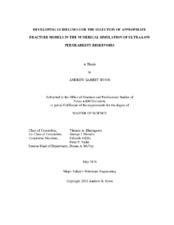| dc.description.abstract | The prediction of production from stimulated ultra-low permeability (ULP) media using
numerical simulation is thought to be highly correlated with the type of fracture model
used in the simulator. Although there are some general rules about the applicability of
these fracture models, there are no guidelines for the a-priori selection of the "most
appropriate" model. In general, the selection of the fracture model is a matter of
preference and/or familiarity of the person performing the modeling. This work presents
modelling cases from the Eagle Ford (TX), Bakken (ND), Three Forks (ND), and
Wolfcamp (TX) ULP formations where we compare and contrast fracture models.
Production data from wells in the aforementioned formations are history-matched using
models commonly available in commercial reservoir simulation programs. A hybrid
simulation model consisting of a symmetry element which represents a single perforation
cluster and accompanying induced fracture network is created. This network consists of
a discrete hydraulic fracture in a media of one of the four following models to represent
the reservoir and a possible stimulated reservoir volume (SRV):
● The equivalent continuum model (ECM)
● The dual porosity model (DP)
● The dual permeability model (DK)
● The multiple interactive continuum model (MINC)
The "most representative" models are selected based on the history-matched data
associated with a given case — and specifically, the physical dimension/relevance of the
parameters that were matched. On a regional level, recommendations of particular models
that provide the best match or appear to be more "applicable" across a reservoir are made.
In addition, we consider and investigate the correlation between the model applicability
and the reservoir attributes, the stimulation design, and the completion methods. These
results are used to generate a set of guidelines that can form a basis for extending the
findings of this work to reservoirs outside of the study. | en |


